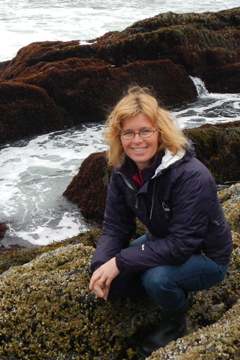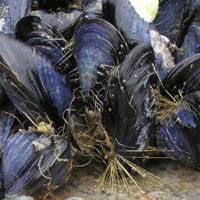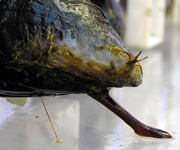Mussels live turbulent lives in the intertidal zone. To compensate for the constant barrage of waves, they hold onto rocks with threads and glue stronger than most materials in nature. Biochemists recognize the unique durability of these “byssal threads.” For more than 15 years, researchers have sought to replicate them for surgical purposes.
But byssus — the combined thread and glue — varies across tide pools. Different mussel species produce different types of threads, and environmental conditions alter the elasticity and strength of the glue strands. To help material scientists mimic threads best suited for conditions within the human body, biologists are trying to figure out how these threads differ in nature.
Marine biologist Emily Carrington of Friday Harbor Laboratories at the University of Washington has studied mussel threads for more than 20 years. She and colleagues published a paper on March 10 in Nature Climate Change [subscription required] showing that our acidifying oceans make threads weaker and less stretchy. In past projects, Carrington also has found that thread strength varies seasonally. For example, blue mussels along the coast of New England make their weakest threads during the summer, right around the time that hurricane season kicks in. This leaves them susceptible to dislodging from rocks during storms.
Carrington presented her work at a symposium on mussel adhesion at the February 2013 meeting of the American Association for the Advancement of Science in Boston. She spoke with SciCom’s Laura Poppick over coffee during a snowy morning at the meeting.
How did you get into mussels?
I started a [postdoctoral] position with John Gosline, a biomaterials expert at the University of British Columbia. The theme of his lab was elastic materials. He's one of the world’s experts on spider silk. Other people in his lab were working on materials like horse hoof and aorta elastin from pigs. I was a marine biologist, so mussel bysuss came up.
Why are mussels important?
They attach to rocks and provide habitat for many organisms. They can also filter about a liter of water per hour. They strain phytoplankton out of the water, bringing all that food down to the benthic community, and sequestering it into a body mass that larger predators then eat. They also make up a $1.5 billion industry worldwide.
Also, mussels have a unique ability to adhere underwater and make durable glues. What mussels can do nicely matches what the medical industry needs.
How so?
They make a glue that rapidly sets and adheres to wet surfaces in saline environments. Our bodies are saline.
I’ve heard that mussel glue is one of the strongest materials on Earth. Is that true?
It's strong, but it's not quite the strongest. Kevlar is an even stronger synthetic material, five times stronger than steel. They use Kevlar to make lightweight bulletproof vests. Spider silk is a natural material that is even stronger than Kevlar. Byssus is special because it's very tough — a combination of strong and stretchy — so it absorbs a lot of energy. And mussels can do all of this underwater.
Is it the thread itself that is strong, the plaque holding on, or both?
The plaque itself is a strong, durable glue. What's most special is that it will adhere to wet surfaces. If you go to the hardware store and grab any strong glue, and try to adhere to the inside of this glass [pointing to her water glass], the glue dissipates into the water and never sets up.
"I’ve had my share of surgeries over the years. If byssus is the ideal suture material, that would be fine with me."
Is this the same glue that, say, barnacles use?
Barnacles use more of a cement, and less is known about that. But it is similar in that it is also good at adhering underwater.
How do mussels make their threads?
The mussel molds a thread. It’s not like a spider, which spins and pulls a fiber out of its body. Instead, a mussel extends its foot and presses the tip against the substrate [rocky surface]. They have a groove in their foot, and they secrete liquid precursors from the vesicles into that groove. It’s just like a five-minute epoxy: You have the two different parts, you squeeze them out, and mix them together. The mussels secrete these parts, and they mix and set within the groove. It takes a minute or two. When the animal takes its foot away, it leaves behind a freshly molded thread.
How do they judge how many threads they need to put down?
I have spent a lot of time thinking about that. It’s a complicated and interesting problem. They have anywhere from 40 to 100 threads in place at a given time. The threads rot, so the mussels need to continuously replace them. But mussels can’t count their own threads, so they don’t have a way to know how strong their attachment is. And they don’t know how fast waves are either. I have always suspected they have some sort of “jiggle sensor,” like the accelerometers in Wii remotes. If a mussel rattles around too much, then it could put down more threads to stabilize itself and get feedback that it was secure. That’s just a hypothesis, but it would be fun to explore.
Your research requires you to work on rugged, rocky coastlines. Have you had some close calls with waves in the field?
I’m pretty cautious. One rule of working in the intertidal zone is, “Never turn your back to the ocean.” When I work in wavier places, we have standard safety practices. You always bring somebody with you. On San Juan Island [north of Puget Sound], we have to work at night sometimes with headlamps if the tides are at night. It’s pretty fun actually. If it is a calm day, then there isn't much danger.
You’re now on sabbatical in Sicily. Why have you gone so far away to study mussels?
My host, Gianluca Sara, is an expert in mussel energetics. He has a model for how a mussel allocates energy — or food — to different functions, such as growth or reproduction, over its lifetime. We want to modify his model to predict how much energy a mussel has available to produce byssus. My data suggests they have nutritional constraints at certain times, because we don’t see across-the-board strong attachment all year. The fact that they are weak at certain times suggests they have made a choice, so to speak, to allocate their limited resources to something else.
Is it the quantity or quality — or both — of their diet that controls this resource reallocation?
That is exactly the question we're working on now. To be confident in our model, we need to validate our predictions against real data we collect in the lab. We have a drip-feeding system, so we can adjust the phytoplankton going in, the temperature, and the pH of the water. The mussels start at a certain size. Over six months, we can measure how much shell and body mass they have, and how many byssal threads they produce. We can compare these measurements to our model predictions. Then we can use all of this to look for those threshold values: the critical environmental conditions that harm mussels in both natural populations and aquaculture.
I’m trying to imagine an intertidal zone without mussels. What would that look like?
We do have them in many places, where mussels don’t do well for various reasons. Generally, macroalgae would dominate instead. If there are no mussels forming dense aggegrations, then it’s lots of slippery algae. I love algae, so that would also be very beautiful, but it is not as good a food source for things like crabs and sea stars. And macroalgae don’t filter water like mussels, so the water could get murkier.
How likely do you think it is that climate change might force these shifts?
I’d say pretty likely. We have plenty of evidence for oceans that are gradually warming and becoming increasingly acidified. But the rate of acidification is much more rapid than the predictions we have seen for ocean temperature. That's a cause for concern.
Do you think mussel farmers have a lot to worry about with climate change?
I do. It will probably take a long time to get to conditions that will actually kill the mussels outright. Before that, we are going to see conditions that could gradually eat into their profits.
What’s next for your research?
We finally have identified specific environmental factors that might explain the seasonal pattern of attachment, so we want to formalize those linkages in the field.
How do you see this directly helping the biomaterial industry?
The foundation of bio-inspired design is a curiosity about how living things work. New insights from nature are an important source of ideas to inspire new applications. In the case of mussels, we have mostly worked on the species common to our local shores. There are many species, and some live in really interesting and extreme environments. One of my favorites lives in hydrothermal vents [miles deep on the seafloor]. How do mussels make their tethers under high pressure?
How long do you think it will take for mussel-inspired threads to become common in surgery?
I think the time is now.
How would you feel if you had mussel byssus put into your body?
In terms of molecular composition, byssus has similarities to collagen and elastin, common proteins in our bodies. So using byssus is not a far stretch by any means.
I’ve had my share of surgeries over the years. If byssus is the ideal suture material, that would be fine with me.
____________________
Laura Poppick, a graduate student in the Science Communication Program at UC Santa Cruz, earned her bachelor's degree in geology from Bates College. At UCSC, she has worked as a reporting intern at the Salinas Californian, the Monterey Bay Aquarium Research Institute, and Wired.com in San Francisco.
© 2013 Laura Poppick



